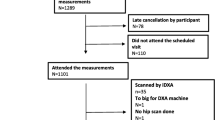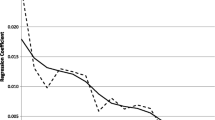Abstract
Introduction: Peak bone mineral area density is the amount of bone tissue present when skeletal maturation is completed. The exact age at which bone accumulation reaches a plateau varies with skeletal region. In Mexico and other Latin American countries, there are very few reports on bone mineral area density at early age. Material and methods: A cross-sectional study of 461 females between 9 and 24 years of age in Cuernavaca, Mexico, distributed proportionately by age group, determined the bone mineral density (BMD) in femur, lumbar spine, and subcranial skeleton, using a Hologic 4500-Series A osteodensitometer. The peak bone mineral area density (PBM) was determined by using the sigmoid growth model defined by Raymond-Pearl (CSRP). Cohort comparisons among different age groups were developed to evaluate BMD in three skeletal regions, with the Dunnett test, comparing the slopes of BMD by each age stratum. Also, the primary determinants of BMD were evaluated through models of multiple linear regression. Results: The timing of PBM is highly site specific with some skeletal regions reaching PBM earlier: beginning with the femur, and later reaching the lumbar spine and subcranial skeleton. Using a multivariate model, age and body weight were important predictors of BMD in the three anatomical regions studied (p<.001). The percentage of fat is associated in an inversely proportionate manner (p<.005), as independent predictors for BMD in the lumbar spine. The age of the onset of menstruation is also a predictor of BMD in the lumbar spine (p<0.05); vigorous activity is an important predictor in the subcranial skeleton (p<0.001). Discussion: For Mexican females in the state of Morelos, the BMD are similar to that reported in a number of ethnic groups. In mestizo females the timing of PBM is highly site specific with some skeletal regions acquiring PBM earlier: specifically, in the femoral region where PBM rapidly reached a plateau. In Mexico, early strategies for preventing osteoporosis should be focused on promoting physical activity and appropriate eating habits (control of obesity, among others) during the puberty stage.


Similar content being viewed by others
References
Bonjour JP, Theintz G, Law F, Slosman D, Rizzoli R (1995) Peak bone mass: facts and uncertainties. Arch Pediatr 2:460–468
Matkovic V, Jelic T, Wardlaw GM, Ilich JZ, Goel PK, Wright JK, Andon MB, Smith KT, Heaney RP (1994) Timing of peack bone mass in Caucasian females and its implication for the prevention of osteoporosis. Inference from a cross-sectional model. J Clin Invest 93(2):799–808
Recker RR, Davies KM, Hinders SM, Heaney RP, Stegman MR, Kimmel DB (1992) Bone gain in young adult women. JAMA 268(17):2403–2408
Hightower L (2000) Osteoporosis: pediatric disease with geriatric consequences. Orthop Nurs 19(5):59–62
Bachrach LK (2001) Acquisition of optimal bone mass in childhood and adolescence. Trends Endocrinol Metab 12(1):22–28
Raisz LG, Prestwood KM (2000) Epidemiology and pathogenesis of osteoporosis. Clin Cornerstone 2(6):1–10
Ponder SW, McCormick D, Fawcet H, Palmer J, McKernan M, Brouhard B (1990) Spinal bone mineral density in children aged 5.0 to 11.99 years. Am J Dis Child 144:1346–1348
McCormick, Ponder SW, Fawcet H, Palmer J (1991) Spinal bone mineral density in 335 normal and obese children and adolescents: evidence for ethnic and sex differences. J Bone Mineral Res 6:570–613
Mazess R, Barden H (1991) Bone density in premenopausal women: effects of age, dietary intake, physical activity, smoking, and birth-control pills. Am J Clin Nutr 53:132–142
Buchanan JR, Myers C, Lloyd T, Leuenberger P, Demers L (1996) Determinants of peak bone trabecular bone density in women: the role of androgens, estrogen and exercise. J Bone Mineral Res 3:673–680
Lloyd T (1992) Determinants of bone density in young women I. relationships among pubertal development, total bone mass and total bone density in premenarchal females. J Clin Endocrinol Metab 75(2):383–387
Hernández-Avila M, Romieu I, Parra-Cabrera S, Hernández-Avila JE, Madrigal H, Willett W (1998) Validity and reproducibility of a food frequency questionnaire to assess dietary intake of women living in México City. Salud Publica Mex 40:133–140
Slosman DO, Meunier PJ, Delmas PD, Sebert JL, DeVernejoul MC, Provvedini DM, Tsouderos Y, Reginster JY (1996) The pivotal role of cross-calibration and quality control in an international clinical trial of the strontium salt S12911 involving multiple DXA brands. Osteoporos Int 6 [Suppl 1]:S168
Hernandez B, Gortmaker SL, Laird NM, Colditz GA, Parra-Cabrera S, Peterson KE (2000) Validez y reproducibilidad de un cuestionario de actividad e inactividad física para escolares de la Ciudad de México. Salud Publica Mex 42:315–323
Ainsworth B, Haskell W, Leon A, Jacobs DR, Montoye HJ, Sallis JF, Paffenbarger RS (1993) Compendium of physical activities: classification of energy costs of human physical activities. Med Sci Sports Exerc 25(1):71–80
Makridakis S, Wheelwright S (1976) Forecasting methods and applications. Wiley, New York
Rivera Dommarco J, Shama T, Villalpando S, González de Cossio T, Hernández-Prado B, Sepúlveda J (2001) Encuesta nacional de nutrición 1999: estado nutricio de niños y mujeres de México. Instituto Nacional de Salud Pública, Cuernavaca Morelos, México
Gortmaker S, Dietz W, Cheung L (1990) Inactivity, diet and the fattening of America. J Am Diet Ass 90(9):1247–1455
Salbe AD, Weyer C, Harper I, Lindsay RS, Ravussin E, Tataranni PA (2002) Assessing risk factors for obesity between childhood and adolescence: II. energy metabolism and physical activity. Pediatrics 110:307–314
Bachrach LK (1993) Bone mineralization in childhood and adolescence. Curr Opin Pediatr 5(4):467–473
Heinonen A, Sievanen H, Kannus P, Oja P, Pasanen M, Vuori I (2000) High-impact exercise and bones of growing girls: a 9-month controlled trial. Osteoporos Int 11(12):1010–1017
Magarey AM, Boulton TJ, Chatterton BE, Schultz C, Nordin BE, Cockington RA (1999) Bone growth from 11 to 17 years: relationship to growth, gender and changes with pubertal status including timing of menarche. Acta Paediatr 88(2):139–146
Taha W, Chin D, Silverberg AI, Lashiker L, Khateeb N, Anhalt H (2001) Reduced spinal bone mineral density in adolescents of an Ultra-Orthodox Jewish community in Brooklyn. Pediatrics 107(5):E79
Rubin LA, Hawker GA, Peltekova VD, Fielding LJ, Ridout R, Cole DE (1999) Determinants of peak bone mass: clinical and genetic analyses in a young female Canadian cohort. J Bone Miner Res 14(4):633–643
Baroncelli GI, Saggese G (2000) Critical ages and stages of puberty in the accumulation of spinal and femoral bone mass: the validity of bone mass measurements. Horm Res 54 [Suppl 1]:2–8
Matsukura T, Kagamimori S, Yamagami T, Nishino H, Iki M, Kajita E, Kagawa Y, Yoneshima H, Matsuzaki T, Marumo F (2000) Reference data of forearm bone mineral density in healthy Japanese male and female subjects in the second decade based on calendar age and puberty onset: Japanese Population Based Osteoporosis (JPOS) study. Osteoporos Int 11(10):858–865
Fournier PE, Rizzoli R, Slosman DO, Theintz G, Bonjour JP (1997) Asynchrony between the rates of standing height gain and bone mass accumulation during puberty. Osteoporos Int 7(6):525–532
Janz KF, Nielsen DH, Cassady SL, Cook JS, Wu YT, Hansen JR (1993) Cross-validation of the Slaughter skinfold equations for children and adolescents. Med Sci Sports Exerc 25(9):1070–1076
Weiler HA, Janzen L, Green K, Grabowski J, Seshia MM, Yuen KC (2000) Percent body fat and bone mass in healthy Canadian females 10 to 19 years of age. Bone 27(2):203–207
Weaver CM (2000) Calcium requirements of physically active people. Am J Clin Nutr 72[Suppl 2]:579S–84S
Bonjour JP, Theintz G, Buchs B, Slosman D, Rizzoli R (1991) Critical years and stages of puberty for spinal and femoral bone mass accumulation during adolescence. J Clin Endocrinol Metab 73:555–563
Acknowledgements
This project was carried out with funds from the Bristol Myers Squibb Foundation in New York, USA, as part of the Request for Proposals for "Better health for women: a global health program."
Author information
Authors and Affiliations
Corresponding author
Additional information
All authors participated in the writing and approval of this article. Eduardo Lazcano-Ponce, Juan Tamayo, Aurelio Cruz, and Mauricio Hernández-Avila were responsible for the conceptualization and design of the project; Eduardo Lazcano-Ponce, Juan Tamayo, Aurelio Cruz, Rodrigo Díaz, Bernardo Hernández, Ramón del Cueto, and Mauricio Hernández-Avila were responsible for the data analysis and interpretation.
Rights and permissions
About this article
Cite this article
Lazcano-Ponce, E., Tamayo, J., Cruz-Valdez, A. et al. Peak bone mineral area density and determinants among females aged 9 to 24 years in Mexico. Osteoporos Int 14, 539–547 (2003). https://doi.org/10.1007/s00198-002-1363-2
Received:
Accepted:
Published:
Issue Date:
DOI: https://doi.org/10.1007/s00198-002-1363-2




